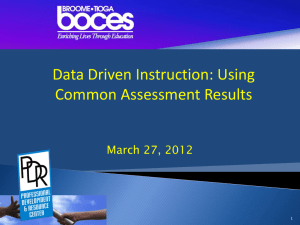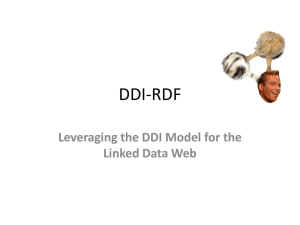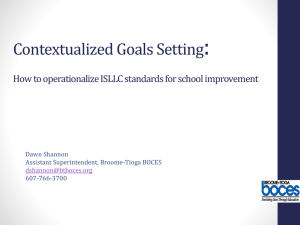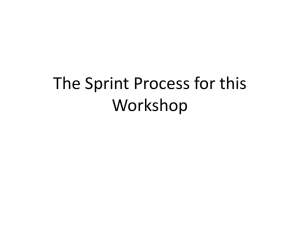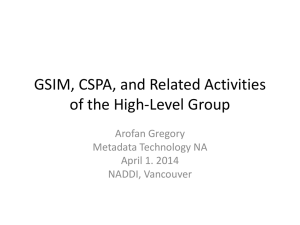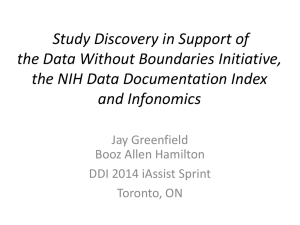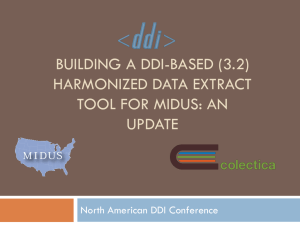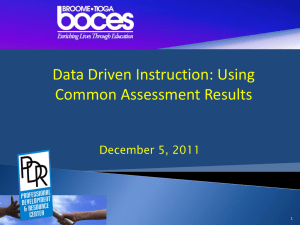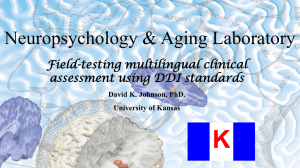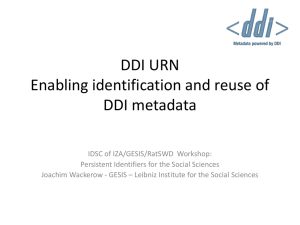Discover the Power of DDI Metadata
advertisement
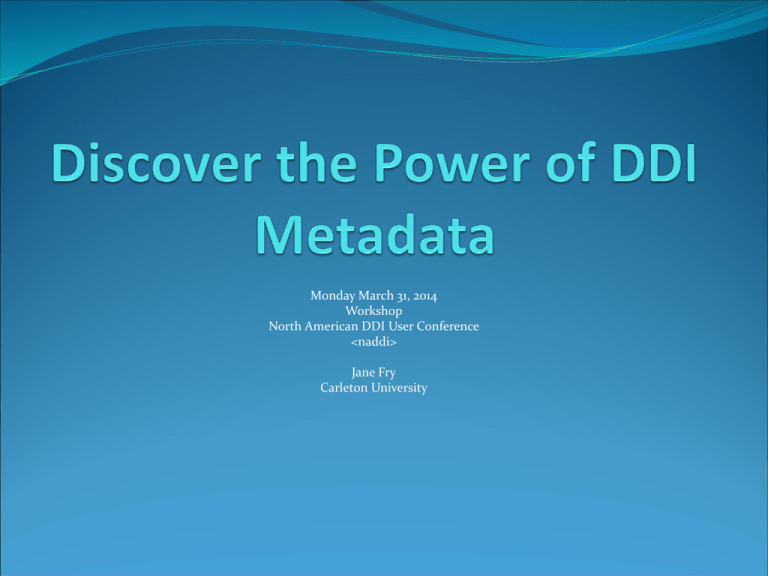
Monday March 31, 2014 Workshop North American DDI User Conference <naddi> Jane Fry Carleton University Schedule Introductions Brief background of DDI Exercise 1 Getting started Examples Integration into a data lifecycle workflow Exercise 2 Wrap-up 2 Brief Background of DDI What is DDI? Data Documentation Initiative http://www.ddi-alliance.org/ An international specification Not yet a formal ISO standard Goal Formats documentation for a social science data file More useful than a word or text file Supports the entire research data lifecycle 3 Brief Background (cont’d) Creates a standard format Used to mark up codebooks Meaningful and consistent Metadata is both human and machine readable Gives codebook level details such as dataset contents, variable labels, summary Statistics and frequencies Also question text for each variable *as long as it was entered when marking up the document 4 Brief Background (cont’d) DDI website (http://www.ddialliance.org/what) Excellent resource FAQ Tools Markup Examples Metadata Resources 5 Brief Background (cont’d) Facilitates the creation of metadata Expressed in XML XML Schema A way of tagging text for meaning, not appearance Older version of DDI used DTD (Document type definition) Defines Which tags are available The order the tags will appear in a document Whether the tags are required or optional Whether the tags are repeatable or not 6 Example of DDI Compliant Codebook <?xml version='1.0' encoding='UTF-8'?> <codeBook version="1.2.2" ID="ctums_82M0020XCB_E_2004_ann_person-file"> <docDscr> <citation> <titlStmt> <titl> Canadian Tobacco Use Monitoring Survey, 2004: Annual, Person File </titl> <subTitl> Annual, Person File </subTitl> <altTitl> CTUMS 2004: Annual, Person File </altTitl> <parTitl> Enquete de surveillance de l'usage du tabac au Canada, 2004: Annuel, Personne </parTitl> <IDNo> ctums_82M0020XCB_E_2004_ann_person-file </IDNo> </titlStmt> <rspStmt> <AuthEnty affiliation="Queen's University. Social Science Data Centre"> Cooper, Alex </AuthEnty> </rspStmt> 7 Brief Background (cont’d) Benefits of DDI Interoperability Rich content A single document with multiple purposes On-line subsetting and analysis Increased search capability precision in searching More visibility for the data because it is web-based Research is no longer on just one computer 8 Brief Background (cont’d) Challenges Complexity Level of researcher buy-in Need for tools Changes in workflow Access to metadata Brief Background (cont’d) History Started in 1995 The director of ICPSR, Richard Rockwell, constituted a Committee on metadata Quebec City Developed a draft list of codebook elements An international committee 10 Brief Background (cont’d) Norwegian Social Science Data Services Harvard University American University Statistics Canada Health Canada Bureau of the Census University of Michigan Bureau of Labor Statistics ICPSR Yale University ESRC Data Archive (UK) University of California, Berkeley University of Southern Denmark The Roper Center Zentralarchiv für Empirische Sozialforschung (GESIS) 11 Brief Background (cont’d) Bjorn Henrichsen Micah Altman Atle Alvheim Grant Blank Ernie Boyko Bill Bradley Cavan Capps Bill Connett Cathryn Dippo Pat Doyle Dan Gillman Peter Granda Ann Green Peter Joftis Ken Miller Tom Piazza Karsten Boye Rasmussen Richard Rockwell Jostein Ryssevik Merrill Shanks Peter Solenberger Rolf Uher Mary Vardigan 12 Brief Background (cont’d) 1996: Prepared first DTD (document type definition) Set up markups/specifications 1997: Received funding from the NSF Specifications translated to XML 1999: Beta testing Reports were submitted 2000: DDI Version 1 published 2001 : First DDI training 2001: Received funding from Health Canada 13 Brief Background (cont’d) 2002: DDI Alliance charter drafted 2003 DDI 2 published DDI Alliance established First Steering Committee meeting Final meeting of original Committee Continues to evolve Not a one-time thing 14 Brief Background (cont’d) Now branched into 2 separate development lines or metadata standards DDI Codebook aka DDIC Formerly DDI2 This was the original one DDI Lifecycle aka DDIL formerly DDI3 Supports the research data lifecycle The one new users are learning 15 Brief Background (cont’d) DDI Alliance Self-sustaining Membership organization Members have a voice in the development of DDI Membership documents are all online Charter, bylaws, member forms, … Publications are all one line Newsletters, annual reports, … http://www.ddialliance.org/alliance 16 Brief Background (cont’d) Who is Using DDI? International CESSDA Data Portal (European quantitative social science datasets) Australian Social Science Data Archive DAMES Project (UK) DataFirst at University of Cape Town Data Liberation Initiative (Statistics Canada) General Social Survey (US) ICPSR (Interuniversity Consortium for Political & Social Research) Israel Social Science Data Center Philippines National Statistics Office Statistics New Zealand Vision of Britain (historical view between 1801 and 2001) World Bank (International Household Survey Network) 17 Global DDI Brief Background (cont’d) What Health Projects are using DDI? Altarum Institute (US) Systems research for better health Centers for Medicare/Medicaid Services (CMS) Denominator File Project The Global Fund to Fight AIDS, Tuberculosis and Malaria MIDUS Series Midlife in the US: A National Study of Health and Well-Being The Tromsø Study (Norway) to determine reasons for high mortality rates due to different diseases UNICEF, Child Information Monitoring the Situation of Children and Women (global development data) 19 Time to think! 20 Exercise 1 As a researcher, what metadata do you absolutely need? How do you want it to streamline your research? What metadata would you like to have, if it is available, but it is not integral to your research? 21 Getting Started with DDI Daunting at first Process is broken down into steps Lots of help available DDI Alliance Colleagues Other researchers DDI List-serv DDI Best Practices Work in progress Feedback always welcome 22 Getting Started with DDI (cont’d) Tools to help you get started http://www.ddialliance.org/resources/tools Drop down menu Browse a list Choose the one that will suit your purposes License choices Commercial Freeware GNU Lesser General Public License (LGPL) For different versions of DDI 23 Getting Started with DDI (cont’d) One tool: Nesstar Publisher Norwegian Social Science Data Services Data management program Freeware Data and metadata conversion and editing tools Enhance datasets Combine catalogue and contextual information Merge DDI documents with markup for different sections of the DDI for the same study Merge variable descriptions from SPSS/SAS with DDI 24 Getting Started with DDI (cont’d) Nesstar Webview Metadata Any associated documentation Variable groups Conduct basic analysis Subsetting Crosstabs Bonus 25 Getting Started with DDI (cont’d) Nesstar Webview Downloading Documentation PDF format Export files with study descriptions and question text Data exported in format of choice SPSS, SAS, Stata, ASCII, … 26 Getting Started with DDI (cont’d) Nesstar drawbacks For advanced statistical analysis it is best to download the data and use a statistical analysis package Must have access to a server to publish the dataset Not intuitive when starting to markup datasets Not intuitive for first-time user in Webview Not a drawback, just a consideration Uses DDI Codebook standard 27 28 29 30 Getting Started with DDI (cont’d) Another tool: Colectica for Excel Based in the US Freeware Documents variables and datasets directly from within Excel Can be used to produce detailed (item-level) metadata for studies already completed Creates metadata and documentation for surveys Saves metadata directly in the Excel file When the file is shared, so is the metadata 31 Getting Started with DDI (cont’d) Colectica for Excel Allows direct importing and documenting of Stata data files (.dta) and SPSS data files (.sav) Will automatically import variable names, labels and code lists from the data file This metadata will be added to the documentation that is already stored Uses DDI Lifecycle (DDI version 3.1) Allows us to manage the entire life cycle of a study as well as manage our legacy materials Records audit trail through versioning 32 Getting Started with DDI (cont’d) Colectica Reader Free tool To view the metadata No specialized software is needed Generates documentation for variables and code lists PDF, Word, HTML 33 Getting Started with DDI (cont’d) Other options available from Colectica Colectica Portal Allows you to browse, search and view the contents of the Repository on the web Free Colectica Repository To store the metadata on a server Not free 34 Colectica workspace Tool bar options This work space is used when entering info for DDI modules 35 ALA DCIG June 23, 2012 4/13/2015 Example codebook from Colectica (PDF) 36 ALA DCIG June 23, 2012 4/13/2015 Getting Started with DDI (cont’d) Remember the two types of DDI? DDI Codebook (DDIC) and DDI Lifecycle (DDIL) Two separate programs Challenge How to go from DDIC to DDIL? Even though DDIL is fast becoming the more preferred one, if you are already using DDIC, it would be too much work to convert to DDIL Insufficient resources to do this conversion for most institutions (people, $) 37 Getting Started with DDI (cont’d) The latest news Nesstar has created a new API Hopefully be able to publish DDI Lifecycle to DDI Codebook on the Nesstar server This integration has been implemented between Nesstar and Colectica Will allow users greater opportunities for Expanded metadata production Improved data publication and visualization 38 Next … We have learned the history of DDI seen who is using it learned how it can streamline our research seen some tools that will help us use it Next, we will look at examples of DDI in 2 tools These are to show you how important it is to have tools that will interpret it for you so you don’t have to know XML 39 Examples of using DDI Check out how Nesstar Webview works Video Tutorial 1: Accessing Health of Houston Survey Data (2 min) http://www.youtube.com/watch?v=NNvcS1xsOEg Video Tutorial 2: Looking at Survey Variables in Nesstar (3 min) http://www.youtube.com/watch?v=xkBGC-5K_Bk Video Tutorial 3: Using the Tabulation Function in Nesstar (4 min) http://www.youtube.com/watch?v=qqTlN5mVRdg 40 Examples of using DDI (cont’d) Check out how Colectica works 11 videos to choose from all are 2 minutes or less http://www.youtube.com/user/Colectica How to Open an Existing Study User Interface Overview Export DDI 3 Generate Documentation 41 Back in 15! 42 Review We have learned the history of DDI who is using it how it can streamline our research We have seen 2 tools and examples Nesstar and Colectica for Excel Remember There are 2 different lines of DDI development DDIC and DDIL 43 Data Lifecycle Workflow Integrating Metadata and Research Data Management into a data lifecycle workflow What metadata When or where to integrate it What does research data management have to do with this 44 Data Lifecycle Workflow (cont’d) DDI Metadata accompanies and enables Data conceptualization Collection Processing Distribution Discovery Analysis Repurposing Archiving 45 Data Lifecycle Workflow (cont’d) Remember More efficient and easier to capture information about all stages of the research workflow at the time of its occurrence rather than after the fact 46 Time to think! 47 Exercise 2 When or where would you like to see metadata integrated into a data lifecycle workflow? What does research data management have to do with this? 48 DDI Research Lifecycle 49 DDI Lifecycle 3.2 http://www.ddi-alliance.org/ 50 51 Workshop Materials To access materials from this workshop They will be on the NADDI Conference website They are also here: http://www.library.carleton.ca/content/na-ddi-north-american-ddi-user-conference 52 References DDI Alliance. <ddi> Data Documentation Initiative. Retrieved March 17, 2014 from http://www.ddi-alliance.org/ GNU. GNU operating system. Retrieved March 18, 2014 from http://www.gnu.org/ Iverson, J. & Stephenson, E. (2013). DDI-Lifecycle and Colectica at the UCLA Social Science Data Archive. Presentation at the North American Data Documentation Conference (NADDI) 2013. http://hdl.handle.net/1808/11049 Vardigan, M. & Wackerow, J. (2013). DDI – A metadata standard for the community. Paper presented at the North American Data Documentation Initiative Conference (NADDI) 2013. http://hdl.handle.net/1808/11056 W3C. Extensible Markup Language (XML). Retrieved March 17, 2014 from http://www.w3.org/XML/ 53 Contact Information Jane Fry Data Specialist MacOdrum Library Carleton University jane.fry@carleton.ca janefry@gmail.com 613.520.2600 x1121 54
